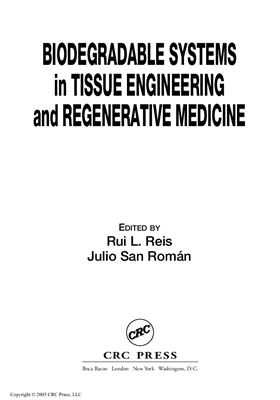CRC PRESS. 2005. ISBN 0-8493-1936-6
Processing and Applications of Biodegradable Systems
Biodegradable Polymers in Medicine
Injectable Biodegradable Systems
Injectable Polymeric Scaffolds for Bone Tissue Engineering
Totally or Partially Biodegradable Self-Polymerizing Composites for Orthopedic Surgery and Dental Applications
Fiber Bonding and Particle Aggregation as Promising Methodologies for the Fabrication of Biodegradable Scaffolds for Hard-Tissue Engineering
Design and Fabrication of Scaffolds via Solid Free-Form Fabrication
Biodegradable Composites for Biomedical Applications
Development of Bioactive Composites Based on Biodegradable Systems for Bone Replacement Applications
Mechanical Characterization of Biomaterials
Chitosan-Based Microcomposites — From Biodegradable Microparticles to Self-Curing Hydrogels
Processing and Biomedical Applications of Degradable Polymeric Fibers
Understanding the Enzymatic Degradation of Biodegradable Polymers and Strategies to Control Their Degradation Rate
Production of Biomimetic Coatings on the Surface of Degradable Polymers
Bonelike Apatite Coatings Nucleated on Biodegradable Polymers as a Way to Induce Bone Mineralization: Current Developments and Future Trends
Biomimetic Coatings, Proteins, and Biocatalysts: A New Approach to Tailor the Properties of Biodegradable Polymers
Systems for Controlled Release of Bioactive Agents
Strategies for Delivering Bone and Cartilage Regenerating Factors
Resorbable Polymeric Delivery Systems Based on Physical Absorption/Diffusion versus Chemically Controlled Delivery Systems
Enzyme Immobilization in Biodegradable Polymers for Biomedical Applications
Use of Chemically Modi?ed Chitosan and Other Natural-Origin Polymers in Tissue Engineering and Drug Delivery
Biocompatibility and Immunological Responses to Degradable Biomaterials
Cytotoxicity Screening of Biodegradable Polymeric Systems
Natural-Origin Degradable Materials: The Barrier or the Passage through the Immune System?
Mediation of the Cytokine Network in the Implantation of Orthopedic Devices
Protein and Cell Interactions with Biodegradable Systems
Surface Activation and Modi?cation — A Way for Improving the Biocompatibility of Degradable Biomaterials
Biodegradable Polymers for the Engineering and Regeneration of Different Tissues
Bone and Articular Cartilage Tissue Engineering: The Biological Components
Tissue Engineering of the Liver
Smart Biodegradable Hydrogels with Applications in Drug Delivery and Tissue Engineering
Skin Tissue Engineering Part I — Review
Skin Tissue Engineering Part II — The In Vitro Evaluation of Natural and Synthetic 3-D Matrices as Dermal Substrates
Biodegradable Polymers for Guided Nerve Regeneration
Processing and Applications of Biodegradable Systems
Biodegradable Polymers in Medicine
Injectable Biodegradable Systems
Injectable Polymeric Scaffolds for Bone Tissue Engineering
Totally or Partially Biodegradable Self-Polymerizing Composites for Orthopedic Surgery and Dental Applications
Fiber Bonding and Particle Aggregation as Promising Methodologies for the Fabrication of Biodegradable Scaffolds for Hard-Tissue Engineering
Design and Fabrication of Scaffolds via Solid Free-Form Fabrication
Biodegradable Composites for Biomedical Applications
Development of Bioactive Composites Based on Biodegradable Systems for Bone Replacement Applications
Mechanical Characterization of Biomaterials
Chitosan-Based Microcomposites — From Biodegradable Microparticles to Self-Curing Hydrogels
Processing and Biomedical Applications of Degradable Polymeric Fibers
Understanding the Enzymatic Degradation of Biodegradable Polymers and Strategies to Control Their Degradation Rate
Production of Biomimetic Coatings on the Surface of Degradable Polymers
Bonelike Apatite Coatings Nucleated on Biodegradable Polymers as a Way to Induce Bone Mineralization: Current Developments and Future Trends
Biomimetic Coatings, Proteins, and Biocatalysts: A New Approach to Tailor the Properties of Biodegradable Polymers
Systems for Controlled Release of Bioactive Agents
Strategies for Delivering Bone and Cartilage Regenerating Factors
Resorbable Polymeric Delivery Systems Based on Physical Absorption/Diffusion versus Chemically Controlled Delivery Systems
Enzyme Immobilization in Biodegradable Polymers for Biomedical Applications
Use of Chemically Modi?ed Chitosan and Other Natural-Origin Polymers in Tissue Engineering and Drug Delivery
Biocompatibility and Immunological Responses to Degradable Biomaterials
Cytotoxicity Screening of Biodegradable Polymeric Systems
Natural-Origin Degradable Materials: The Barrier or the Passage through the Immune System?
Mediation of the Cytokine Network in the Implantation of Orthopedic Devices
Protein and Cell Interactions with Biodegradable Systems
Surface Activation and Modi?cation — A Way for Improving the Biocompatibility of Degradable Biomaterials
Biodegradable Polymers for the Engineering and Regeneration of Different Tissues
Bone and Articular Cartilage Tissue Engineering: The Biological Components
Tissue Engineering of the Liver
Smart Biodegradable Hydrogels with Applications in Drug Delivery and Tissue Engineering
Skin Tissue Engineering Part I — Review
Skin Tissue Engineering Part II — The In Vitro Evaluation of Natural and Synthetic 3-D Matrices as Dermal Substrates
Biodegradable Polymers for Guided Nerve Regeneration

